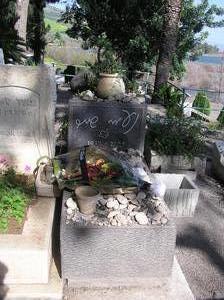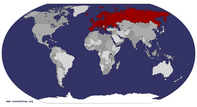Advertisement
Published: February 23rd 2005

 Naomi Shemer's grave
Naomi Shemer's grave
Naomi Shemer's grave at Kinneret CemeteryWednesday.
Up early again. Today we move on to Jerusalem. Suitcases outside the door at 7 am, down to breakfast. And everyone made it to the bus at 8 am and we’re off!
Our first stop was at the Kinneret Cemetery (just south of Lake Kinneret, also known as the Sea of Galilee.) Many early Zionist pioneers are buried in this cemetery - including the poetess Rachel. She was so famous that she is know simply by her first name. Zvi, our guide, talked about the early pioneers who prided themselves on their physical labors, and had no room for those who could not handle the rigors of that rough life. Rachel was one of those who loved the land and the work, but could not physically match up. She had to leave and go to the city, and it broke her heart. Zvi read to us a few of her poems, then we wandered a bit and looked at the graves of others buried there. One of the recent graves was that of the wonderful singer and writer, Naomi Shemer, who passed away just last summer. She was the composer of Yerushalayim Shel Zahav (Jerusalem of Gold) among

 Tree planting
Tree planting
My little tree at the Golani Junction of the Jewish National Fund. Hope it grows strong!many other well-known Israeli songs of the last four decades. There were many flowers on her grave - new bouquets. Several groups of Israeli school children were just leaving when we arrived, so we assumed they had brought the flowers in her honor.
Next stop, the Golani Junction. Here we were able to plant small saplings, adding our own trees to what will one day be a hillside forest. Looking across at the adjacent hill covered with trees we could easily imagine how our little ones would grow. It was good to put our hands in the soil. The project is run by the Jewish National Fund which has been planting trees and carrying out other environmental projects for decades. Jewish school children around the world (and adults, too) collect funds to plant these trees, usually around the holiday of Tu Bishevat (the 15th of the Hebrew month of Shevat), known also as Chag Ha-Ilanot, the Holiday of the Trees. It is always so strange back in the U.S. to be sending money off to plant trees when our own backyards are covered in snow. So much fun to be in Israel just a few days after Tu Bishevat

 Druse Visit
Druse Visit
Two wonderful Druse women baking pita for our group.and actually see the springtime spreading through the countryside!
Our next stop was a Druse village. The Druse are a people and also a religion. They broke away from Islam a thousand years ago and have been persecuted by Islam ever since. Their religion is secretive in many aspects - ritual especially. But its basic teachings are ethics and honesty and respect. It is a closed religion: no one can convert in, and anyone who married out is permanently removed from the religion. An interesting aspect is that children are given a choice at age 15 to either become a “religious” Druse (with special customs, education, and stricter way of life) or to be a secular Druse who follows just the basics of loyalty and ethics. People in the same household can choose different ways - religious parents may have secular adult children living with them, or vice versa. They are very accepting of individual choice. All of the Druse believe in reincarnation, and that a Druse will only be reincarnated as a Druse. The woman who ran the seminar/discussion for us told her own family’s story of her grandfather who disappeared one day, and five years later a

 Yemin Orde Youth Village
Yemin Orde Youth Village
Our group taking a tour of the community, as we go past the synagogue.small child from a nearby village showed up with his father at her family’s home. He came in and called each of them by name, added other details, and told them where “his” body was buried - since he was their grandfather reincarnated. Cool, huh? The Druse are very friendly. They are spread out in 5 or 6 different countries, including Israel. One of their beliefs is that you should be completely loyal to the nation in which you live. So the Druse serve in the Israeli army with pride. At the end of the talk, we were served a traditional meal - pita bread with Oregano, a lentil dish, rice, some delicious olives from the family’s own trees, hummus, salads, etc. Delicious. Fun to just take big soft pieces of warm pita bread and scoop up other foods from the large platters.
Three stops already, and the day is not yet done! We get back in the bus and drive toward Haifa. Unfortunately, we cannot visit that beautiful city on this trip, though I have been there several times. We are due at Yemin Orde Youth Village. I have visited there a couple of times, and was very excited to have the group see this wonderful community. Youth Villages in Israel were originally established by Youth Aliyah (through the Jewish Agency) to help at risk and immigrant children who came to Israel after the Holocaust. Today, there are many of these communities continuing to serve children and primarily teens. Yemin Orde is a unique version: founded in 1953 by British friends of Youth Aliyah, and run today by the well-respected educational pioneer, Dr. Chaim Peri. He was not there the day we visited, as he was in the U.S. for a Board meeting of the “Friends of Yemin Orde” so we met with Susan instead. She is amazing herself - having come to Yemin Orde after working many years helping resettle Ethiopian Jews in Israel. Yemin Orde makes the teens into a community, and provides a village that is a home not only until they graduate high school and enter the army, but even for years to come. Many leaders have come from Yemin Orde. The teens are mostly at risk - often immigrants and sometimes just from troubled families or neighborhoods in large cities or development towns. Many of the current students are either Ethiopian Israelis, Russian Jewish (and non-Jewish) immigrants, and Brazilian teens who come over at first for one year and usually decide to make aliyah (immigrate). A new program which takes in younger children was recently added. Yemin Orde respects students’ native cultures, and encourages the community to share their customs and practices. They also do wonderful outreach work in the summers: to children who were victims of terrorists, and to Russian children from the inner city who come for a “fresh air camp” and self-esteem building.
Susan emphasized the pride the community takes in the success of their students. One of the two finalists on the “Ambassador” television show that was just completed this past week in Israel was an Ethiopian Israeli woman who had spent time at Yemin Orde. I was so impressed with Mahareta when I saw her on television - poised and well spoken and so proud of her country. Knowing she came through Yemin Orde reinforced my great respect for this community.
We toured a bit; saw the beautiful synagogue (the village is nominally Orthodox, but no one is forced to follow any specific religious practices), the teens hanging out after classes, and met two returning graduates who are now in university but came back for a reunion. Both were Ethiopian Israelis who credited Yemin Orde with changing the direction of their lives. As we were leaving, I left some tzedaka with Susan, to support the community in their work.
Back in the bus, we were finally off on the drive to Tel Aviv. It was very late in the afternoon, and the sun was going down as we drove. We took the newer highway - K’vish 6. It runs near the Green Line (that older border from before the 1967 war.) We could see the parts of the “fence” that is erected now between Israel and the “territories” that will one day be a Palestinian entity. Indeed, it is a fence in most places - a wire fence with a road on either side, or two fences with a wide dirt road in between. Looks just like a border. Only in the few places where it is close to Palestinian homes or buildings does it become a tall wall. The wall allows the “fence” to be much narrower: does not require wide dirt roads on either side, which would have meant clearing land to provide the safety zone. What a paradox: the tall cement wall actually is more sensitive to leaving Palestinian buildings intact while still providing security from terrorists; if a fence were used in those same places - property would have been confiscated. Over all, most of the fence was fence - actually electronic fence. Not electric - but electronic. If someone touches it an alert goes off at a post nearby and soldiers can be sent along the road to check it out. We drove close to several well known Palestinian towns: Tulkarm, Kalkilya. (Little did we know that just 2 nights later a resident of Tulkarm would become a suicide bomber, a terrorist, and blow himself up killing innocent Israelis at a club along the Mediterranean in Tel Aviv.)
We turned east and headed along the next highway, toward Jerusalem. The traffic picked up as it was the end of the day. We started climbing through the hills. Before the last turn into the city, the bus pulled over to the side of the road on the busy street. We filed out onto the sidewalk under two thin trees; each took a cup of wine, and we recited a psalm and blessings for coming up into Jerusalem, including the Shehechiyanu blessing (for momentous occasions.) Back once more on the bus, we drove another fifteen minutes to our hotel, the David Citadel on King David Street.
The hotel was as nice as I remembered. Elyse and I were sharing a room, and we had a great balcony with a spectacular view of the Old City - looking up toward Jaffa Gate. No more group activities that night, so I checked in with my old college friend Steve who lives in Lod, and he set off to come to Jerusalem to visit. Since that is a long drive, I headed off for a walk up to the popular Ben Yehuda Street area. Many restaurants, regular stores and tourist stores are in that area. I was able to buy a few of the Hebrew Dr. Seuss books that temple members had requested, but the jewelry store I wanted to visit was closed already. Met up with Steve (he’s been living in Israel for almost 30 years) and we went up to a café/restaurant on Yaffa Street and had a light supper. The place was pretty empty when we arrived around 8:30 pm, but was completely full by 10 pm as we were leaving. Even on a Wednesday evening, the town is hopping. Lots of young people - Israelis, not tourists. Our only complaint everywhere we go: so much cigarette smoking. Ugh.
Advertisement
Tot: 0.238s; Tpl: 0.011s; cc: 5; qc: 45; dbt: 0.0391s; 1; m:domysql w:travelblog (10.17.0.13); sld: 8;
; mem: 1.1mb









